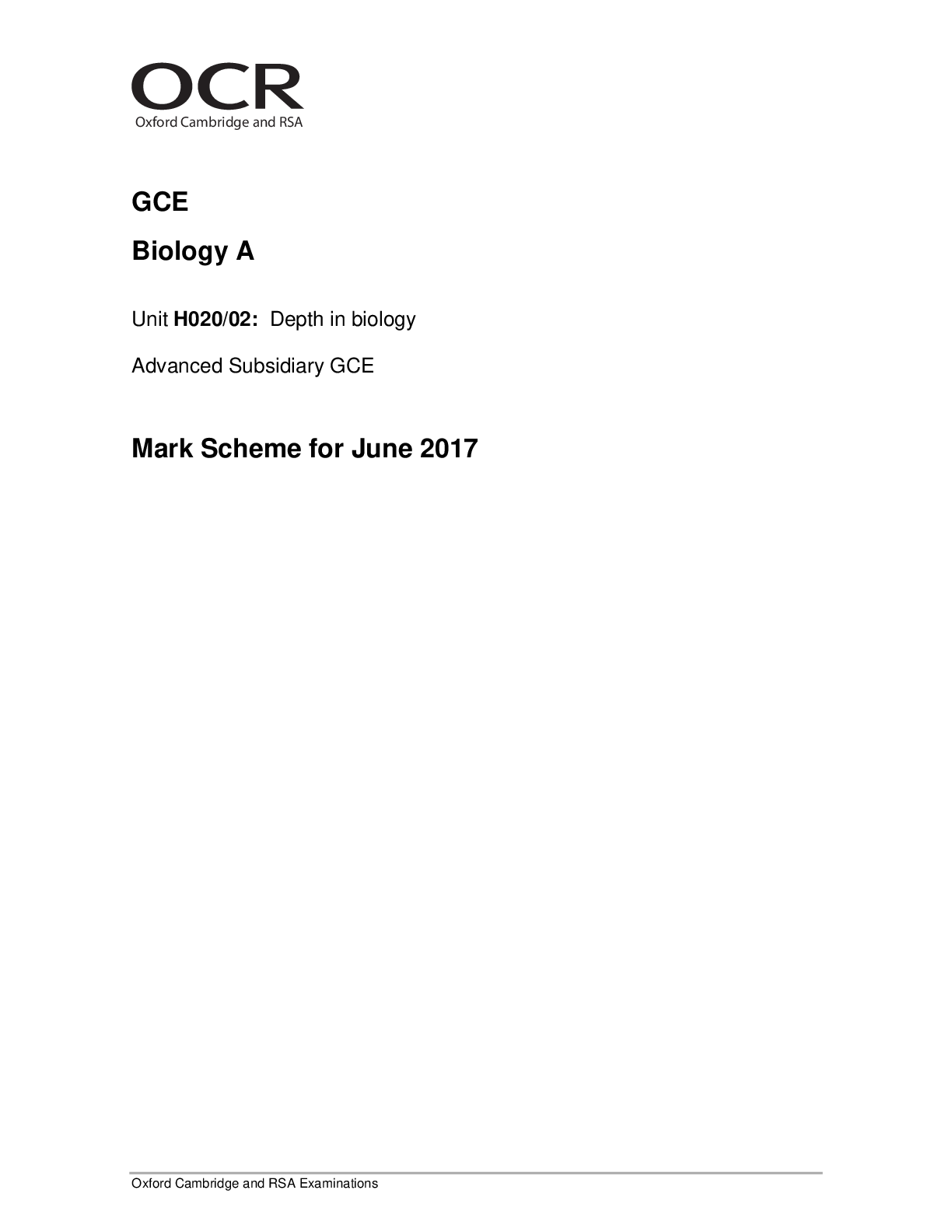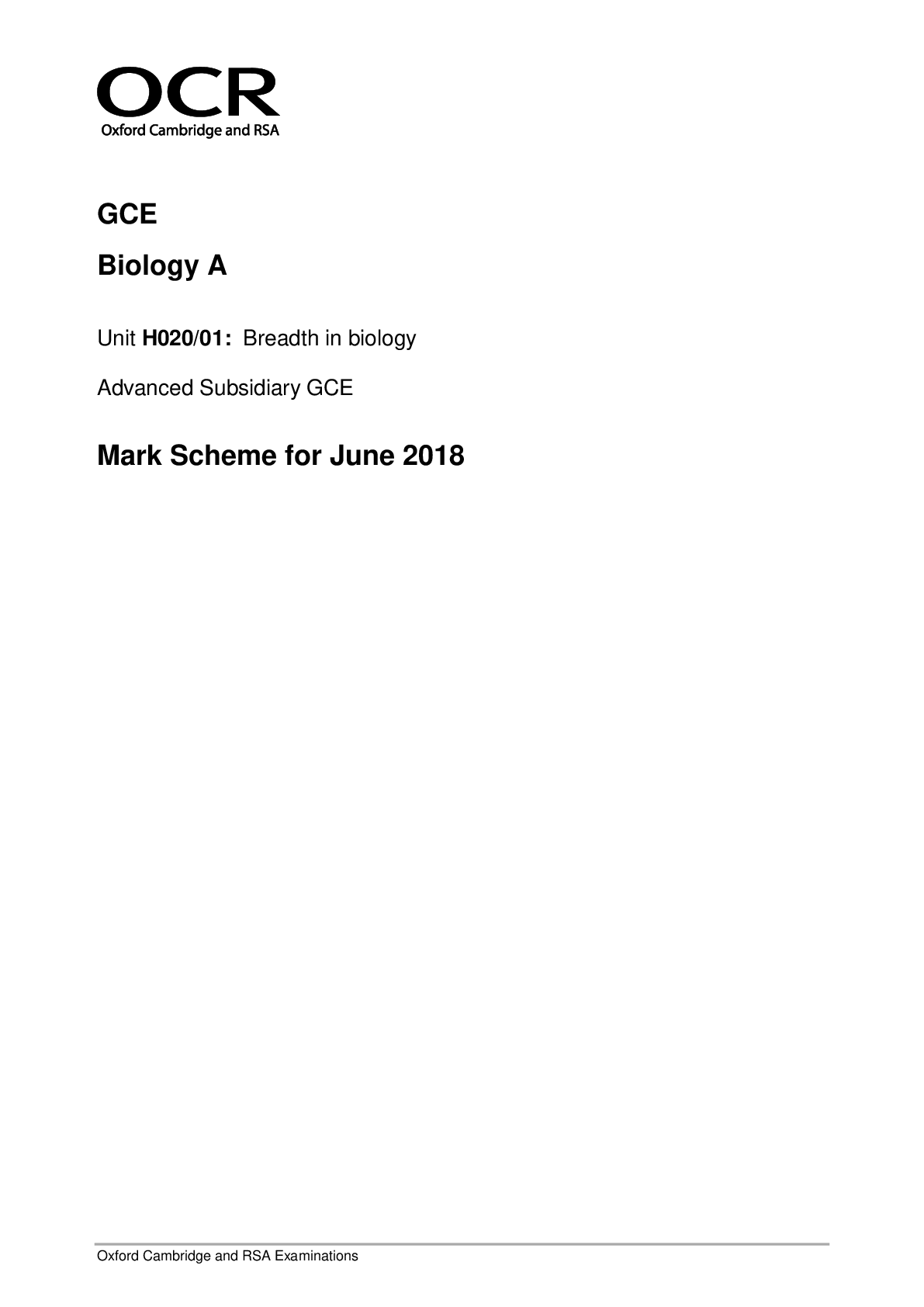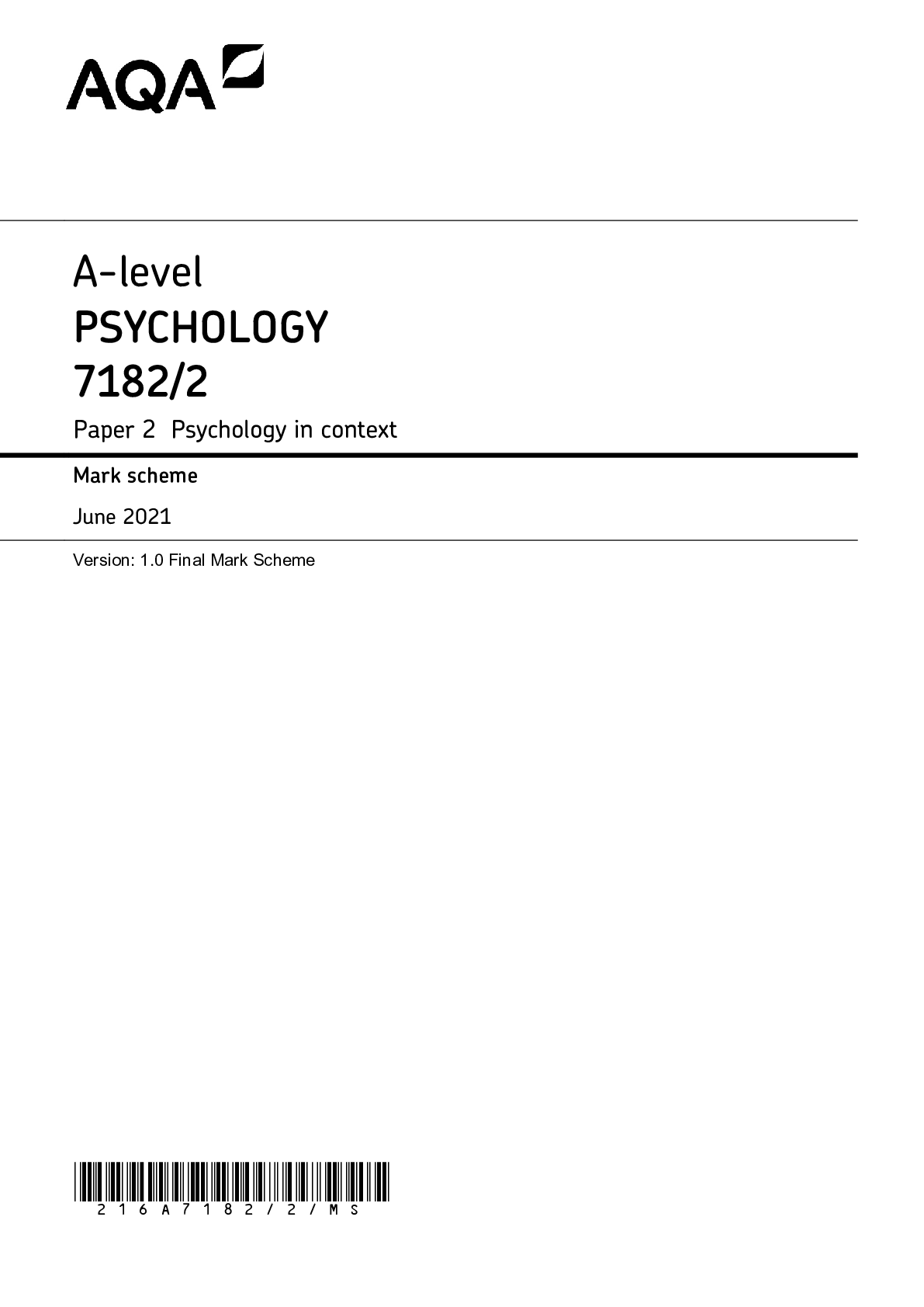Philosophy > MARK SCHEMES > GCE Psychology H167/01: Research methods Advanced Subsidiary GCE Mark Scheme for November 2020 (All)
GCE Psychology H167/01: Research methods Advanced Subsidiary GCE Mark Scheme for November 2020
Document Content and Description Below
GCE Psychology H167/01: Research methods Advanced Subsidiary GCE Mark Scheme for November 2020 Oxford Cambridge and RSA Examinations GCE Psychology H167/01: Research methods Advanced Subsid... iary GCE Mark Scheme for November 2020Oxford Cambridge and RSA Examinations OCR (Oxford Cambridge and RSA) is a leading UK awarding body, providing a wide range of qualifications to meet the needs of candidates of all ages and abilities. OCR qualifications include AS/A Levels, Diplomas, GCSEs, Cambridge Nationals, Cambridge Technicals, Functional Skills, Key Skills, Entry Level qualifications, NVQs and vocational qualifications in areas such as IT, business, languages, teaching/training, administration and secretarial skills. It is also responsible for developing new specifications to meet national requirements and the needs of students and teachers. OCR is a not-for-profit organisation; any surplus made is invested back into the establishment to help towards the development of qualifications and support, which keep pace with the changing needs of today’s society. This mark scheme is published as an aid to teachers and students, to indicate the requirements of the examination. It shows the basis on which marks were awarded by examiners. It does not indicate the details of the discussions which took place at an examiners’ meeting before marking commenced. All examiners are instructed that alternative correct answers and unexpected approaches in candidates’ scripts must be given marks that fairly reflect the relevant knowledge and skills demonstrated. Mark schemes should be read in conjunction with the published question papers and the report on the examination. © OCR 2020H167/01 Mark Scheme November 2020 Annotations Annotation Meaning Unclear Attempts evaluation Benefit of doubt Context Cross Evaluation Extendable horizontal line Extendable horizontal wavy line Significant amount of material that doesn’t answer the question Not answered question Good use of resources Tick Development of point Omission markH167/01 Mark Scheme November 2020 Section A: Multiple Choice Quest Answer 1 B 2 C 3 A 4 A 5 B 6 C 7 A 8 B 9 D 10 D 11 D 12 C 13 B 14 A 15 CH167/01 Mark Scheme November 2020 Section B: Research Design and Response Question Answer Marks Guidance Write a two-tailed alternative hypothesis for this study. [3] 16 For example ... (accept variations in operational decisions of IV and DV) There will be a significant difference in the ability to concentrate (solving anagrams) when doodling (scribbling whatever liked) compared to not doodling. 3 mark answer: Correctly cited alternative hypothesis with both IV and DV operationalised 2 mark answer: Correctly cited alternative hypothesis with reference to both variables but neither or only one operationalised 1 mark answer: Simply stating ‘there will be a difference’ OR An alternative hypothesis with reference to just one variable 0 marks: No credit worthy information Max 3 Context – doodling, drawing, scribbling, concentration etc - Can be written in future or present tense - Use of the word significant is not necessary for full marks - Award zero for citing a null alternative hypothesis - Award zero if reference to ‘relationship’ or ‘correlation’ - For full marks both the IV and DV must be operationalisedH167/01 Mark Scheme November 2020 Explain how you would conduct a study using the experimental method to investigate if people are able to concentrate better when doodling compared to when not doodling. Justify your decisions as part of your explanation. You must refer to: [12] - use of repeated measures design - how you would operationalise the dependent variable (DV) in a way that would produce quantitative data - the control of one extraneous variable You should use your own experience of practical activities to inform your response. Question Answer Marks Guidance 17 Max 12 Context = doodling, drawing, scribbling, concentration etcH167/01 Mark Scheme November 2020 Level of Response Details of required features (RFs) included Justification of decisions made Reference to own practical work Good 10-12 marks - All 3 required features addressed - Accurate and detailed knowledge and understanding of each feature in context - Good evidence of application of required features in context -Appropriatejustificationof all decisions and some is contextualised - Well developedline of reasoningthat is clear and logicallystructured - Explicit reference to own practical work and clear links between own work and the planned research for each required feature e.g. specific mention of aim or procedural features - For top level, 10 marks if one RF linker, 11 marks if two and 12 marks if all three - If there is no explicit link between own practical work and any of the three required features – max 9 marks Reasonable 7-9 marks - All 3 required features addressed - Reasonably accurate and detailed knowledge and understanding of each feature - At least two applications of required features in context - Some appropriate justification of decisions related to all three required features - Bottom of the band if only two required features justified - There was some line of reasoning evident with some structure It two required features are addressed in detail and justified in context and explicit links made to own practical work – award 8 marks Limited 4–6 marks - Two of the required features addressed - Limited application of required features - OR all three required features referred to but in a limited way - Attempt to justify decision(s) but weak - Evidence of some structure, but weak If one required feature is addressed in detail and justified in context and explicit links made to own practical work – award 4 marks Basic 1-3 marks - One of the required features addressed - Weak application of required features OR more than one of the required features referred to but in a very brief and/or basic way - None, or if present very weakH167/01 Mark Scheme November 2020 Outline how you would use random sampling to obtain a sample of 20 participants for this study from a group of 120 students in a lecture theatre at a university. [3] Question Answer Marks Guidance 18 (a) For example: Random sampling could be used by writing the name of all the 120 students in a lecture theatre at a university on slips of paper, put the slips of paper in a box, shake it up and pull out 20 slips of paper. The names of the students on these slips of paper would then be asked to participate in the study on doodling and concentration. 3 mark answer: Clear description of how random sampling could be used, in context 2 mark answer: Clear description of how random sampling could be used but not in context OR Attempt in context 1 mark answer: Brief and/or unclear description of random sampling (whether in context or not) 0 marks: No credit worthy information Max 3 - Context – doodling, drawing, scribbling, concentration etcH167/01 Mark Scheme November 2020 Outline one strength of using random sampling to obtain participants for this study [3] (b) Answers could include: More representative of the effect of doodling on concentration of students as all students have had an equal chance of being selected, can generalise findings about the effects of doodling on concentration better etc 3 mark answer: Clear outline of strength in context 2 mark answer: Clear outline of strength but not in context OR Attempted outline of strength in context 1 mark answer: Brief and/or weak attempt to outline strength (whether in context or not) 0 marks: No credit worthy information Max 3 - Context – doodling, drawing, scribbling, concentration etcH167/01 Mark Scheme November 2020 Name the sampling technique you used in any one of your own practical activities and outline one strength of obtaining participants in this way for your study [3] 19 Answer here relates to one of the candidates own practical activities 3 mark answer: Clear outline of strength in context 2 mark answer: Clear outline of strength but not in context OR Attempted outline of strength in context 1 mark answer: Brief and/or weak attempt to outline strength (whether in context or not) 0 marks: If a sampling technique is simply named No credit worthy information 3 Context – the theme of the candidates own chosen practical activityH167/01 Mark Scheme November 2020 Outline one strength and one weakness of not having any qualitative data in this study [6] 20 Strengths could include: easy to analyse data; easy to compare across individuals and conditions Weaknesses could include: don’t know reasons why doodling may/may not affect concentration; lack of detail in general Up to 3 marks for each strength / weakness 3 mark answer: Clear outline of strength/weakness in context 2 mark answer: Clear outline of strength/weakness but not in context OR Attempted outline of strength/weakness in context 1 mark answer: Brief and/or weak attempt to outline strength /weakness (whether in context or not) 0 marks: No credit worthy information Max 6 - Context – doodling, drawing, scribbling, concentration etc Note: Accept interchanging strengths/weaknesses of qualitative data. For example if a candidate has given a weakness of qualitative data as a strength of now having qualitative data in the study.H167/01 Mark Scheme November 2020 Outline how you could obtain some nominal data in this study [2] 21 (a) For example: Participants could be asked a closed question asking them to choose one of the following: ❑ Doodling helped me focus ❑ Doodling distracted me ❑ Doodling neither helped me focus or distracted me 2 mark answer: Categories in context 1 mark answer: An attempt at categories 0 marks: No credit worthy information Max 2 - Context – doodling, drawing, scribbling, concentration etc Note: Candidate must outline categories that relate to collection of data regarding the IV. Do not accept categories relating to the IV such as ‘doodling’ and ‘not doodling’.H167/01 Mark Scheme November 2020 (b) Answers could include: provides more insight about the reason why doodling did / did not help concentration; can create fixed choice response options that allow ideas why doodling may help concentration or not to be explored more etc 3 mark answer: Clear outline of strength in context 2 mark answer: Clear outline of strength but not in context OR Attempted outline of strength in context 1 mark answer: Brief and/or weak attempt to outline strength (whether in context or not) 0 marks: No credit worthy information Max 3 - Context – doodling, drawing, scribbling, concentration etcH167/01 Mark Scheme November 2020 Section C: Data analysis and interpretation Question Answer Mark Guidance What level of data has been collected in this study? Give reasons for your answer [2] 22 Nominal as the data is just frequent count of the number of males and females who did or did not use their phone whilst walking 2 mark answer: Correct data identified and clear justification in context 1 mark answer: Correct data identified and justified but not in context OR Correct data identified and a brief attempt to justify why in context OR Correct data identified 0 marks: No credit worthy information Max 2 Context = mobile, phone, walk(ing), texting etcH167/01 Mark Scheme November 2020 Outline two conclusions that can be made from the data collected in this study 23 For example: Overall, most people walk whilst using their mobile, which suggests that they may think they are too busy to stop whilst doing what they are on their phone; more males than females walk whilst using their phone, which suggests that females may be more self-conscious of using their phone whilst walking than males and prefer to stop whilst doing so. Up to 2 marks for each conclusion 2 mark answer: Clear outline of conclusion in context 1 mark answer: Clear outline of conclusion but not in context OR Attempted outline of conclusion in context 0 marks: No credit worthy information Max 4 Context = mobile, phone, walk(ing), texting etc Must be conclusions (interpretation of data), and not simply stating findings (if so cap at 1 mark max, whether one or two findings stated)H167/01 Mark Scheme November 2020 Draw a fully labelled pie chart displaying the data from this study [4] 24 Pie chart showing percentage of males and females walking or not whilst using their mobile phones 1 mark for correctly calculating what proportion of the circle should represent each of the four behavioural categories. 1 mark for drawing the sectors in proportional size to the data displayed 1 mark for clear labelling of each sector of the pie chart 1 mark is awarded for a clear and appropriate title Max 4 Context = mobile, phone, walk(ing), texting etc Sectors of the pie chart need only be approximate sizes (examiners do not need to check with protractor or overlay in RM assessor) Calculations can be percentages and/or degrees (decimal places or whole figures) of circle (within labelling of the pie chart, or separately at the side) Females walking 58/200 x 100 = 29% 58/200 x 360 = 104.4 degrees Females not walking 26/200 x 100 = 13% 58/200 x 360 = 46.8 degrees Males walking 84/200 x 100 = 42% 84/200 x 360 = 151.2 degrees Males not walking 32/200 x 100 = 16% 32/200 x 360 = 57.6 degreesH167/01 Mark Scheme November 2020 Calculate the overall percentage of people using their phones whilst walking. Show your workings [3] 25 71% 84 males + 58 females = 142 in total 142/200 * 100 = 71% 3 mark answer: Correct answer with full workings shown 2 mark answer: Correct answer with some workings shown 1 mark answer: Correct answer with no workings shown 0 marks: No credit worthy information Max 3H167/01 Mark Scheme November 2020 Explain why the chi-square would be the appropriate non-parametric inferential statistical test to use to analyse the data from this study [3] 26 (a) Reasons: - test of difference (the study investigated the difference between males/females walking or not whilst using mobile phone) - nominal data collected (frequency count of people using phone or not whilst walking) - independent measures design (males vs females using phone or not whilst walking) 3 mark answer: Two appropriate reasons provided, both in context 2 mark answer: Two appropriate reasons provided, but only one, or neither in context 1 mark answer: One appropriate reason provided but, not in context 0 marks: No credit worthy information Max 3 -Context = mobile, phone, walk(ing), texting etcH167/01 Mark Scheme November 2020 Using the extract of the tables of critical values for the chi-square test presented below, what is the critical value at the 5% probability level for data collected in this study? [2] (b) The critical value is 3.841 2 mark answer: Critical value stated 1 mark answer: Degrees of freedom correctly identified as 1 but without stating the critical value from the table (or incorrectly stating the critical value) 0 marks: No credit worthy information Max 2 If a candidate just circles the correct critical value in the table award 2 marks (as to be able to do this requires knowledge of what df to use) Award 1 mark if df = 1 is just circled on the table (so remember to check table) The calculated value of chi-square is 0.2681. Write the significance statement at the 5% level of probability for this study [3] (c) X2 = 0.2681, df=1, p>0.05 OR in words e.g. this is not a significant result (at the 5% probability level) because the calculated value of X2 had to be equal to or exceed the table critical value (3.841) to be significant, therefore we reject the alternative hypothesis and accept the null hypothesis 2 mark answer: Correctly written significance statement (calculated value, degrees of freedom and probability level) OR written in words rather than a formal statement 1 mark answer: Just stating p>0.05 OR weak and/or brief written response 0 marks: No credit worthy information Max 2H167/01 Mark Scheme November 2020 Name the appropriate inferential statistical test to analyse the data from any one of your own practical activities. Give reasons for your answer [4] 27 Depends on candidates own practical activity 4 mark answer: Appropriate test named and justified with two or more clear reasons in context 3 mark answer: Appropriate test named and justified with one clear reason in context 2 mark answer: Appropriate test named and justified, but not in context 1 mark answer: Appropriate test named and weak attempt to justify why (whether in context or not) OR correct test named only 0 marks: No credit worthy information Max 4 Context here = the theme of the candidates own chosen practical activity If incorrect test named = zero, regardless of whether any justification is provided or not (and regardless of whether the justification relates to the correct test) Cap at 2 marks if correct test named and reasons given, but one is incorrectOCR (Oxford Cambridge and RSA Examinations) The Triangle Building Shaftesbury Road Cambridge CB2 8EA [Show More]
Last updated: 2 years ago
Preview 1 out of 21 pages

Buy this document to get the full access instantly
Instant Download Access after purchase
Buy NowInstant download
We Accept:

Reviews( 0 )
$7.50
Can't find what you want? Try our AI powered Search
Document information
Connected school, study & course
About the document
Uploaded On
Oct 07, 2022
Number of pages
21
Written in
Additional information
This document has been written for:
Uploaded
Oct 07, 2022
Downloads
0
Views
73



















.png)






